“Light airs and fine weather, which gave us an opportunity to carry out boath the bowers, the one on the starboard quarter and the other right astern. The spare stream anchor we likewise carried out, and got purchases upon all the cables, and hove taught upon all the 5 anchors. At 4 it was low water, so far as we could judge by the rocks about the ship and part of the shoal being dry, which we had not seen before. The rise and fall of the water did not appear to exceed 3 or 4 feet. As the tide began to rise the leak incresed, which obliged us to set the 3rd pump to work, which we should have done the 4th also could we have made it deliver any water. The ship now righted, and the leak gained on the pumps in such a manner that it became a matter of consideration whether we should heave her off or no in case she floated, for fear of her going down with us in the deep water; but as I thought we should be able to run her ashore, either upon the same shoal or upon the main, in case we could not keep her, I resolved at all risks to heave her off if possible, and accordingly tur’nd as many men to the capstan and windlass as could be spar’d from the pumps, and at 20 minutes past ten hove her afloat and into deep water.” (He did not do this without losing his anchors, as he tells us, but)
“The pumps gain’d on the leak these 4 hours. Some hands employ’d sowing oakem, wool, etc., into a sail to fother the ship. Weigh’d the coasting anchor and warped out to the S.E., and at 11 got under sail, with a light breeze at E.S.E., and stood in for the land, having a small boat laying upon the point of the shoal, the south point of which at noon bore north, distant one mile. The pumps gain’d upon the leak this 4 hours. Light airs and clear weather. Standing off the shore in for the main. Got up the main topmast and main-yard. Having got the sail ready for fothering the ship, we put it over under the starboard fore chains, where we suspected she suffer’d most, and soon after the leak decreas’d so much as to be kept clear with one pump with ease. This fortunate circumstance gave new life to everyone on board. Anchor’d in 17 fathom water, 5 leagues from the land, and about 3 miles from the shore.”
On the 17th they found a harbour where they hove the ship down and repaired her, when it was found that—
“One of the holes, which was big enough to have sunk us if we had had eight pumps instead of four, and had been able to keep them incessantly going, was in great measure plugged up by a fragment of the rock, which, after having made the wound, was left sticking in it; so that the water which had at first gained upon our pumps was what came in at the interstices between the stone and the edges of the hole that received it.”
Endeavour River, Cape Flattery, Providential Channel, and other names on the chart commemorate the accident; yet after all this trouble Cook continued his survey, sailing safely through the cluster of rocks between New Guinea and the mainland. This passage and the Barrier Reef are probably two of the most dangerous places in the world, and more vessels have been wrecked on that bit of coast between the southern end of the Barrier Reef and the Indian Ocean side of Torres Straits than on any similar stretch of coast-line anywhere.




